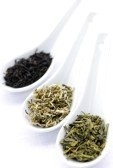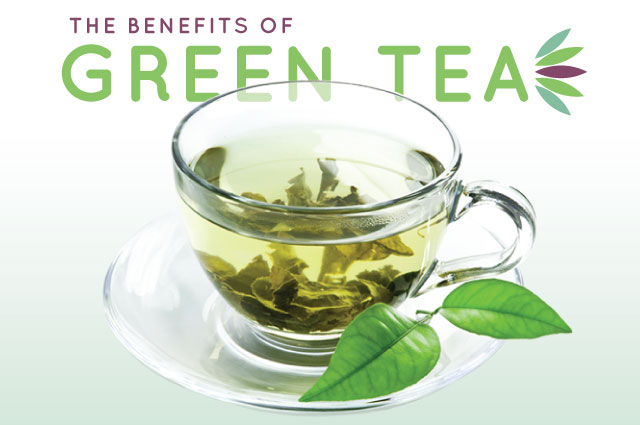Green tea is known to provide many health benefits through regular consumption. It’s best known to promote weight loss and have incredible antioxidant properties.
It contains a minimum amount of caffeine so it can give you a healthy boost of energy in the morning or during a midday lull. Green tea is one of my favorite beverages and I enjoy drinking it on a near daily basis.
Benefits
1. Anti-Cancer – Green tea contains a powerful antioxidant called epigallocatechin gallate (EGCG), which has been shown to kill and inhibit the growth of cancer cells while leaving healthy tissues unharmed.
2. Promotes Brain Health – EGCG is able to cross the blood brain barrier and can help lower levels of inflammation in the brain.
3. Weight Loss – Consuming green tea increases your metabolism that allows your body to burn fat more efficiently. Many studies prove this.
4. Improves Oral Health – Green tea kills bacteria in your mouth that can decrease dental plaque and helps eliminate bad breath.
5. Lowers Bad Cholesterol – Regular consumption of green tea can help lower bad cholesterol levels (LDL cholesterol).
6. Helps Prevent Blood Clots – EGCG can inhibit the formation of abnormal blood clots, which are the leading cause of heart attacks and strokes.
7. Increases Immunity – EGCG increases the number of immune cells (T-cells) that can help suppress autoimmune diseases.
8. Slows The Aging Process – Antioxidants help protect us against free radicals that come about by day to day activities such as exercise, breathing and eating. Neutralizing these free radicals with the antioxidants in green tea slows the aging process.
If you can’t drink green tea you can get some of the same benefits by taking Green Tea Extract supplements that contain EGCG, the active helpful ingredient in green tea.
Types of Tea
 The word “tea” includes a wide variety of drinks. However, green tea, black tea and oolong tea all originate from the same plant. The tea plant (Camellia Sinensis) is one of species of evergreen shrubs and trees that belong to the tea family. The foliage is emerald green and the flowers are yellow and white and very fragrant.
The word “tea” includes a wide variety of drinks. However, green tea, black tea and oolong tea all originate from the same plant. The tea plant (Camellia Sinensis) is one of species of evergreen shrubs and trees that belong to the tea family. The foliage is emerald green and the flowers are yellow and white and very fragrant.
So, if most tea comes from the same plant, why are there so many varieties of tea? The answer lies in what happens to the tea after it is picked. Tea can be divided into three broad categories: unfermented, semi fermented and fermented. Fermentation refers to the oxidation of the tea leaf. Oxidation occurs when an object reacts with oxygen in air or water. It causes some metals to rust and the surface of a cut apple to turn brown. The same process happens when tea leaves are picked and left to dry.
Green Tea is unfermented (un-oxidized) tea. There are two ways to stop the fermentation process, steaming or roasting. For Japanese varieties of tea, steaming is used almost exclusively. Immediately after picking, the leaves are steamed to stop the fermentation process; they are then rolled and dried. Preventing fermentation gives the tea its distinctive taste and green color.
Black and Oolong teas are fermented teas. The tea leaf is fully fermented in black tea products. After picking, the leaf is withered in the sun or with a flow of unheated air. Once withered, the tea is rolled to break up the cell structure in the leaf and to promote further oxidation. This gives the tea it characteristic dark color and aroma. Oolong is semi-fermented tea. Here the tea is dried to reduce the moisture content but the process is stopped before the leaf is completely dry. It is then heated in a pan to stop the oxidation process. The result is a tea that is not as dark as black tea.
Besides affecting color and aroma, fermentation also impacts the health benefits of tea. For example, prior to fermentation, a tea leaf contains catechins, a powerful antioxidant, and a green tea drinker benefits from them. During the production of black tea, the fermentation process changes the catechins into theaflavin. Fermentation also reduces the content of some of the vitamins in the tea. For example, there is vitamin C in green tea although black tea does not have any.
 Matcha is one of my favorite green teas. Matcha is the tea used in the Japanese Tea Ceremony. The tea leaves are shaded from the sun for about one month before being picked. This brings out an extraordinarily sweet taste with no bitterness. The manufactured leaves are then ground like flour to produce a fine green powder. Brewing a cup of Matcha is done using a bamboo whisk (Chasen) to produce a frothy green liquid. Compared to other teas, Matcha has a relatively short shelf life and should be consumed shortly after purchase. Matcha is also popular as a food seasoning just like an herb. There are numerous recipes using this flavorful powder, the simplest of which is sprinkling some over vanilla ice cream.
Matcha is one of my favorite green teas. Matcha is the tea used in the Japanese Tea Ceremony. The tea leaves are shaded from the sun for about one month before being picked. This brings out an extraordinarily sweet taste with no bitterness. The manufactured leaves are then ground like flour to produce a fine green powder. Brewing a cup of Matcha is done using a bamboo whisk (Chasen) to produce a frothy green liquid. Compared to other teas, Matcha has a relatively short shelf life and should be consumed shortly after purchase. Matcha is also popular as a food seasoning just like an herb. There are numerous recipes using this flavorful powder, the simplest of which is sprinkling some over vanilla ice cream.
Caffeine
For a morning pick me up, green tea is a great alternative to coffee. The average cup of coffee contains between 100 and 150mg of caffeine compared to green tea, which contains around 25mg. Factors that influence the caffeine content of green tea are brewing time (the longer it’s steeped, the more caffeine) and the type of green tea.
If needed, you can find decaffeinated green tea. There are two ways in which caffeine is removed from green tea. The healthy way involves using carbon dioxide and water. The other process involves treating the green tea with a chemical solvent (ethyl acetate). Be on the lookout for green tea labeled “naturally decaffeinated,” which is produced using ethyl acetate and should be avoided. This terminology is misleading. You can also remove the caffeine from green tea yourself by simply brewing the tea for one minute and throwing out the water. The second brewing will have very little caffeine.
My advice? Drink some green tea every day. Replace your daily coffee with this immeasurably healthy brew. It will help you with your goal (and mine).
Has green tea helped you lose weight? Heal your health condition? What kinds and brands do you love? Tell me your story by leaving a comment below.









